
Physalis is a genus of approximately 75 to 90 flowering plants in the nightshade family (Solanaceae), which are native to the Americas and Australasia. At least 46 species are endemic to Mexico. Cultivated and weedy species have been introduced worldwide. A defining feature of Physalis is a large, papery husk derived from the calyx, which partly or fully encloses the fruit. Many species bear edible fruit, and some species are cultivated.
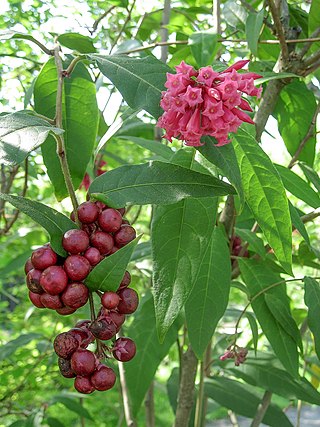
Cestrum is a genus of — depending on authority — 150-250 species of flowering plants in the family Solanaceae. They are native to warm temperate to tropical regions of the Americas, from the southernmost United States south to the Bío-Bío Region in central Chile. They are colloquially known as cestrums or jessamines.
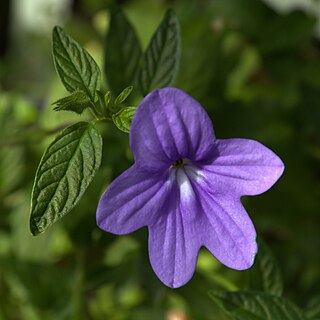
Browallia is a small genus of seven species of flowering plants belonging to the nightshade family Solanaceae. It is named after Johannes Browallius (1707–1755), also known as Johan Browall, a Swedish botanist, physician and bishop. The genus is closely related to the monotypic genus Streptosolen, the single species of which was published initially under the name Browallia jamesonii.
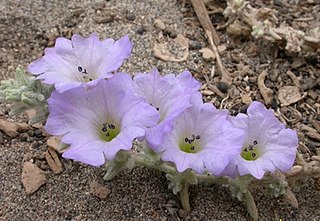
Nolana is a genus of hard annual or perennial plants in the nightshade family. The genus is mostly native to Chile and Peru. Species in this genus, especially N. paradoxa, serve as a model system for studies on flower color.

Iochroma arborescens is a species of flowering plant in the genus Iochroma, belonging to the nightshade family Solanaceae. Formerly it was considered the single species in the monotypic genus Acnistus. Common names include gallinero, mata-gallina, fruta-de-sabiá, hollowheart, wild tobacco, siyou, bastard sirio, galán arbóreo, tabaco de monte, nigüito, marieneira, güitite, and tabak djab.
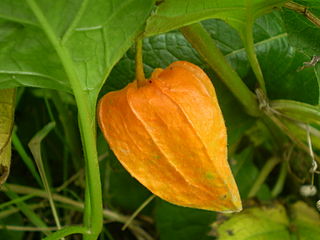
Physaleae is a tribe of flowering plants in the subfamily Solanoideae of the family Solanaceae.

Nicandra is a genus of flowering plant in the family Solanaceae, native to western South America. It was first described by Michel Adanson in 1763. The genus is named for Greek poet Nicander of Colophon, who wrote about plants – notably in his poem Alexipharmaca, which treats of poisons and their antidotes.

Jaltomata is a genus of plants in the family Solanaceae. According to molecular phylogenies, Jaltomata is the sister genus to Solanum, which includes tomato, potato, and eggplant. Jaltomata has a neotropical distribution, in that species occur from the United States southwest through Latin America, and into the Andean region of South America. Species encompass a wide range of vegetative and reproductive trait variation, including growth habit, floral size, shape and color, as well as fruit size and color. The fruits of some of the species are eaten by humans in Latin and South America. Depending on the species, fruits may be red, green, orange, or dark purple.

Capsicum is a genus of flowering plants in the nightshade family Solanaceae, native to the Americas, cultivated worldwide for their edible fruit. Bell peppers, sweet peppers and some chili peppers belong to the Capsicum annuum species, making it the most cultivated species from the genus.

The Solanaceae, or the nightshades, are a family of flowering plants that ranges from annual and perennial herbs to vines, lianas, epiphytes, shrubs, and trees, and includes a number of agricultural crops, medicinal plants, spices, weeds, and ornamentals. Many members of the family contain potent alkaloids, and some are highly toxic, but many—including tomatoes, potatoes, eggplant, bell and chili peppers—are used as food. The family belongs to the order Solanales, in the asterid group and class Magnoliopsida (dicotyledons). The Solanaceae consists of about 98 genera and some 2,700 species, with a great diversity of habitats, morphology and ecology.

Juanulloa, the goldfingers, are a genus of flowering plants in the family Solanaceae, native to Central and South America.

Witheringia is a genus of flowering plants in the family Solanaceae, with a neotropical distribution. It is closely related to Physalis.
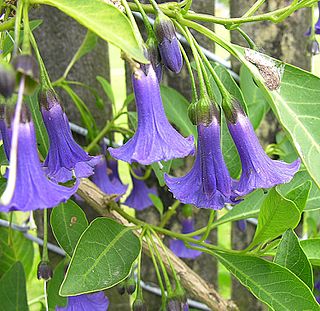
Eriolarynx is a genus of flowering plants in the family Solanaceae, found in Peru, Bolivia and northern Argentina. Their trumpet-shaped flowers are pollinated by hummingbirds, and to a lesser extent, bees.

Eriolarynx australis, called mini angel's trumpet or blue angel's trumpet, is a species of flowering plant in the genus Eriolarynx, native to Bolivia and northwest Argentina. It is widely listed in the horticultural literature under the synonym Iochroma australe. It has gained the Royal Horticultural Society's Award of Garden Merit.
Deprea is a genus of flowering plants belonging to the family Solanaceae.
Saracha is a genus of flowering plants belonging to tribe Physaleae of subfamily Solanoideae of the nightshade family Solanaceae. The genera most closely related to Saracha are Iochroma, Dunalia, and Vassobia.

Salpichroa is a genus of flowering plants belonging to the family Solanaceae.
Leptoglossis is a genus of flowering plants belonging to the family Solanaceae.


















